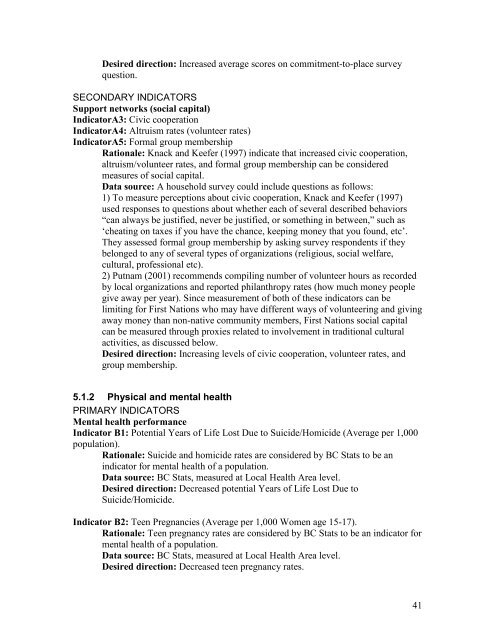Final report - Integrated Land Management Bureau
Final report - Integrated Land Management Bureau
Final report - Integrated Land Management Bureau
You also want an ePaper? Increase the reach of your titles
YUMPU automatically turns print PDFs into web optimized ePapers that Google loves.
Desired direction: Increased average scores on commitment-to-place survey<br />
question.<br />
SECONDARY INDICATORS<br />
Support networks (social capital)<br />
IndicatorA3: Civic cooperation<br />
IndicatorA4: Altruism rates (volunteer rates)<br />
IndicatorA5: Formal group membership<br />
Rationale: Knack and Keefer (1997) indicate that increased civic cooperation,<br />
altruism/volunteer rates, and formal group membership can be considered<br />
measures of social capital.<br />
Data source: A household survey could include questions as follows:<br />
1) To measure perceptions about civic cooperation, Knack and Keefer (1997)<br />
used responses to questions about whether each of several described behaviors<br />
“can always be justified, never be justified, or something in between,” such as<br />
‘cheating on taxes if you have the chance, keeping money that you found, etc’.<br />
They assessed formal group membership by asking survey respondents if they<br />
belonged to any of several types of organizations (religious, social welfare,<br />
cultural, professional etc).<br />
2) Putnam (2001) recommends compiling number of volunteer hours as recorded<br />
by local organizations and <strong>report</strong>ed philanthropy rates (how much money people<br />
give away per year). Since measurement of both of these indicators can be<br />
limiting for First Nations who may have different ways of volunteering and giving<br />
away money than non-native community members, First Nations social capital<br />
can be measured through proxies related to involvement in traditional cultural<br />
activities, as discussed below.<br />
Desired direction: Increasing levels of civic cooperation, volunteer rates, and<br />
group membership.<br />
5.1.2 Physical and mental health<br />
PRIMARY INDICATORS<br />
Mental health performance<br />
Indicator B1: Potential Years of Life Lost Due to Suicide/Homicide (Average per 1,000<br />
population).<br />
Rationale: Suicide and homicide rates are considered by BC Stats to be an<br />
indicator for mental health of a population.<br />
Data source: BC Stats, measured at Local Health Area level.<br />
Desired direction: Decreased potential Years of Life Lost Due to<br />
Suicide/Homicide.<br />
Indicator B2: Teen Pregnancies (Average per 1,000 Women age 15-17).<br />
Rationale: Teen pregnancy rates are considered by BC Stats to be an indicator for<br />
mental health of a population.<br />
Data source: BC Stats, measured at Local Health Area level.<br />
Desired direction: Decreased teen pregnancy rates.<br />
41
















